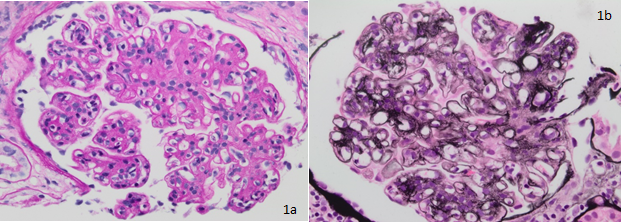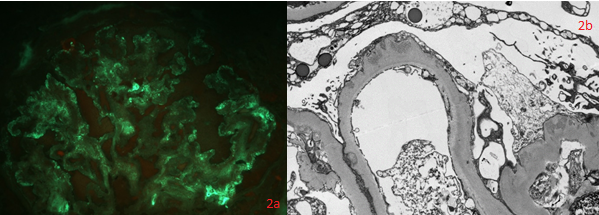[1]
Ljungberg B, Bensalah K, Canfield S, Dabestani S, Hofmann F, Hora M, Kuczyk MA, Lam T, Marconi L, Merseburger AS, Mulders P, Powles T, Staehler M, Volpe A, Bex A. EAU guidelines on renal cell carcinoma: 2014 update. European urology. 2015 May:67(5):913-24. doi: 10.1016/j.eururo.2015.01.005. Epub 2015 Jan 21
[PubMed PMID: 25616710]
[2]
Heilbrun ME, Remer EM, Casalino DD, Beland MD, Bishoff JT, Blaufox MD, Coursey CA, Goldfarb S, Harvin HJ, Nikolaidis P, Preminger GM, Raman SS, Sahni A, Vikram R, Weinfeld RM. ACR Appropriateness Criteria indeterminate renal mass. Journal of the American College of Radiology : JACR. 2015 Apr:12(4):333-41. doi: 10.1016/j.jacr.2014.12.012. Epub
[PubMed PMID: 25842014]
[3]
Vikram R, Beland MD, Blaufox MD, Moreno CC, Gore JL, Harvin HJ, Heilbrun ME, Liauw SL, Nguyen PL, Nikolaidis P, Preminger GM, Purysko AS, Raman SS, Taffel MT, Wang ZJ, Weinfeld RM, Remer EM, Lockhart ME. ACR Appropriateness Criteria Renal Cell Carcinoma Staging. Journal of the American College of Radiology : JACR. 2016 May:13(5):518-25. doi: 10.1016/j.jacr.2016.01.021. Epub 2016 Mar 23
[PubMed PMID: 27016804]
[4]
Jacobs BL, Tan HJ, Montgomery JS, Weizer AZ, Wood DP, Miller DC, Wolf JS Jr, Hafez KS. Understanding criteria for surveillance of patients with a small renal mass. Urology. 2012 May:79(5):1027-32. doi: 10.1016/j.urology.2011.12.052. Epub
[PubMed PMID: 22546379]
Level 3 (low-level) evidence
[5]
Lang EK, Macchia RJ, Gayle B, Richter F, Watson RA, Thomas R, Myers L. CT-guided biopsy of indeterminate renal cystic masses (Bosniak 3 and 2F): accuracy and impact on clinical management. European radiology. 2002 Oct:12(10):2518-24
[PubMed PMID: 12271393]
[6]
Caoili EM, Davenport MS. Role of percutaneous needle biopsy for renal masses. Seminars in interventional radiology. 2014 Mar:31(1):20-6. doi: 10.1055/s-0033-1363839. Epub
[PubMed PMID: 24596436]
[7]
Remer EM, Papanicolaou N, Casalino DD, Bishoff JT, Blaufox MD, Coursey CA, Dighe M, Eberhardt SC, Goldfarb S, Harvin HJ, Heilbrun ME, Leyendecker JR, Nikolaidis P, Oto A, Preminger GM, Raman SS, Sheth S, Vikram R, Weinfeld RM. ACR Appropriateness Criteria(®) on renal failure. The American journal of medicine. 2014 Nov:127(11):1041-1048.e1. doi: 10.1016/j.amjmed.2014.05.014. Epub 2014 May 24
[PubMed PMID: 24865874]
[8]
National Kidney Foundation. KDOQI Clinical Practice Guideline for Diabetes and CKD: 2012 Update. American journal of kidney diseases : the official journal of the National Kidney Foundation. 2012 Nov:60(5):850-86. doi: 10.1053/j.ajkd.2012.07.005. Epub
[PubMed PMID: 23067652]
Level 2 (mid-level) evidence
[9]
Fiorentino M, Bolignano D, Tesar V, Pisano A, Van Biesen W, D'Arrigo G, Tripepi G, Gesualdo L, ERA-EDTA Immunonephrology Working Group. Renal Biopsy in 2015--From Epidemiology to Evidence-Based Indications. American journal of nephrology. 2016:43(1):1-19. doi: 10.1159/000444026. Epub 2016 Feb 5
[PubMed PMID: 26844777]
[10]
Fuiano G, Mazza G, Comi N, Caglioti A, De Nicola L, Iodice C, Andreucci M, Andreucci VE. Current indications for renal biopsy: a questionnaire-based survey. American journal of kidney diseases : the official journal of the National Kidney Foundation. 2000 Mar:35(3):448-57
[PubMed PMID: 10692270]
Level 3 (low-level) evidence
[11]
Motzer RJ, Jonasch E, Agarwal N, Bhayani S, Bro WP, Chang SS, Choueiri TK, Costello BA, Derweesh IH, Fishman M, Gallagher TH, Gore JL, Hancock SL, Harrison MR, Kim W, Kyriakopoulos C, LaGrange C, Lam ET, Lau C, Michaelson MD, Olencki T, Pierorazio PM, Plimack ER, Redman BG, Shuch B, Somer B, Sonpavde G, Sosman J, Dwyer M, Kumar R. Kidney Cancer, Version 2.2017, NCCN Clinical Practice Guidelines in Oncology. Journal of the National Comprehensive Cancer Network : JNCCN. 2017 Jun:15(6):804-834. doi: 10.6004/jnccn.2017.0100. Epub
[PubMed PMID: 28596261]
Level 1 (high-level) evidence
[12]
Uppot RN, Harisinghani MG, Gervais DA. Imaging-guided percutaneous renal biopsy: rationale and approach. AJR. American journal of roentgenology. 2010 Jun:194(6):1443-9. doi: 10.2214/AJR.10.4427. Epub
[PubMed PMID: 20489082]
[13]
Tan HJ, Jacobs BL, Hafez KS, Montgomery JS, Weizer AZ, Wood DP Jr, Miller DC, Wolf JS Jr. Understanding the role of percutaneous biopsy in the management of patients with a small renal mass. Urology. 2012 Feb:79(2):372-7. doi: 10.1016/j.urology.2011.09.050. Epub
[PubMed PMID: 22310755]
Level 3 (low-level) evidence
[14]
Campbell S, Uzzo RG, Allaf ME, Bass EB, Cadeddu JA, Chang A, Clark PE, Davis BJ, Derweesh IH, Giambarresi L, Gervais DA, Hu SL, Lane BR, Leibovich BC, Pierorazio PM. Renal Mass and Localized Renal Cancer: AUA Guideline. The Journal of urology. 2017 Sep:198(3):520-529. doi: 10.1016/j.juro.2017.04.100. Epub 2017 May 4
[PubMed PMID: 28479239]
[15]
Patel IJ, Davidson JC, Nikolic B, Salazar GM, Schwartzberg MS, Walker TG, Saad WE, Standards of Practice Committee, with Cardiovascular and Interventional Radiological Society of Europe (CIRSE) Endorsement, Standards of Practice Committee of the Society of Interventional Radiology. Addendum of newer anticoagulants to the SIR consensus guideline. Journal of vascular and interventional radiology : JVIR. 2013 May:24(5):641-5. doi: 10.1016/j.jvir.2012.12.007. Epub
[PubMed PMID: 23622037]
Level 3 (low-level) evidence
[16]
Patel IJ, Rahim S, Davidson JC, Hanks SE, Tam AL, Walker TG, Wilkins LR, Sarode R, Weinberg I. Society of Interventional Radiology Consensus Guidelines for the Periprocedural Management of Thrombotic and Bleeding Risk in Patients Undergoing Percutaneous Image-Guided Interventions-Part II: Recommendations: Endorsed by the Canadian Association for Interventional Radiology and the Cardiovascular and Interventional Radiological Society of Europe. Journal of vascular and interventional radiology : JVIR. 2019 Aug:30(8):1168-1184.e1. doi: 10.1016/j.jvir.2019.04.017. Epub 2019 Jun 20
[PubMed PMID: 31229333]
Level 3 (low-level) evidence
[17]
Davidson JC, Rahim S, Hanks SE, Patel IJ, Tam AL, Walker TG, Weinberg I, Wilkins LR, Sarode R. Society of Interventional Radiology Consensus Guidelines for the Periprocedural Management of Thrombotic and Bleeding Risk in Patients Undergoing Percutaneous Image-Guided Interventions-Part I: Review of Anticoagulation Agents and Clinical Considerations: Endorsed by the Canadian Association for Interventional Radiology and the Cardiovascular and Interventional Radiological Society of Europe. Journal of vascular and interventional radiology : JVIR. 2019 Aug:30(8):1155-1167. doi: 10.1016/j.jvir.2019.04.016. Epub 2019 Jun 20
[PubMed PMID: 31229332]
Level 3 (low-level) evidence
[18]
Rafiei P, Walser EM, Duncan JR, Rana H, Ross JR, Kerlan RK Jr, Gross KA, Balter S, Bartal G, Abi-Jaoudeh N, Stecker MS, Cohen AM, Dixon RG, Thornton RH, Nikolic B, Society of Interventional Radiology Health and Safety Committee. Society of Interventional Radiology IR Pre-Procedure Patient Safety Checklist by the Safety and Health Committee. Journal of vascular and interventional radiology : JVIR. 2016 May:27(5):695-9. doi: 10.1016/j.jvir.2016.03.002. Epub 2016 Mar 31
[PubMed PMID: 27038685]
[19]
Mal F, Meyrier A, Callard P, Altman JJ, Kleinknecht D, Beaugrand M, Ferrier JP. Transjugular renal biopsy. Lancet (London, England). 1990 Jun 23:335(8704):1512-3
[PubMed PMID: 1972443]
[20]
Levi IM, Ben-Dov IZ, Klimov A, Pizov G, Bloom AI. Transjugular kidney biopsy: enabling safe tissue diagnosis in high risk patients. The Israel Medical Association journal : IMAJ. 2011 Jul:13(7):425-7
[PubMed PMID: 21838185]
[21]
Maya ID, Maddela P, Barker J, Allon M. Percutaneous renal biopsy: comparison of blind and real-time ultrasound-guided technique. Seminars in dialysis. 2007 Jul-Aug:20(4):355-8
[PubMed PMID: 17635829]
[22]
Agarwal SK, Sethi S, Dinda AK. Basics of kidney biopsy: A nephrologist's perspective. Indian journal of nephrology. 2013 Jul:23(4):243-52. doi: 10.4103/0971-4065.114462. Epub
[PubMed PMID: 23960337]
Level 3 (low-level) evidence
[23]
Gesualdo L, Cormio L, Stallone G, Infante B, Di Palma AM, Delli Carri P, Cignarelli M, Lamacchia O, Iannaccone S, Di Paolo S, Morrone L, Aucella F, Carrieri G. Percutaneous ultrasound-guided renal biopsy in supine antero-lateral position: a new approach for obese and non-obese patients. Nephrology, dialysis, transplantation : official publication of the European Dialysis and Transplant Association - European Renal Association. 2008 Mar:23(3):971-6
[PubMed PMID: 17977877]
[24]
Hatfield MK, Beres RA, Sane SS, Zaleski GX. Percutaneous imaging-guided solid organ core needle biopsy: coaxial versus noncoaxial method. AJR. American journal of roentgenology. 2008 Feb:190(2):413-7. doi: 10.2214/AJR.07.2676. Epub
[PubMed PMID: 18212227]
[25]
Marconi L, Dabestani S, Lam TB, Hofmann F, Stewart F, Norrie J, Bex A, Bensalah K, Canfield SE, Hora M, Kuczyk MA, Merseburger AS, Mulders PFA, Powles T, Staehler M, Ljungberg B, Volpe A. Systematic Review and Meta-analysis of Diagnostic Accuracy of Percutaneous Renal Tumour Biopsy. European urology. 2016 Apr:69(4):660-673. doi: 10.1016/j.eururo.2015.07.072. Epub 2015 Aug 29
[PubMed PMID: 26323946]
Level 1 (high-level) evidence
[26]
Sakai H, Abe K, Kobayashi Y, Koyama A, Shigematsu H, Harada T, Yoshikawa N, Arakawa M, Itoh H, Osawa G. Clinical guidelines of IgA nephropathy. Nihon Jinzo Gakkai shi. 1995 Aug:37(8):417-21
[PubMed PMID: 7563948]
[27]
Yoshinari M, Suzuki R, Watanabe K, Katoh T, Watanabe T. How long is enough: length of renal needle biopsy specimen for histological diagnosis. American journal of nephrology. 2002 Jul-Aug:22(4):402
[PubMed PMID: 12169878]
[28]
Walker PD, Cavallo T, Bonsib SM, Ad Hoc Committee on Renal Biopsy Guidelines of the Renal Pathology Society. Practice guidelines for the renal biopsy. Modern pathology : an official journal of the United States and Canadian Academy of Pathology, Inc. 2004 Dec:17(12):1555-63
[PubMed PMID: 15272280]
Level 1 (high-level) evidence
[29]
Manno C, Strippoli GF, Arnesano L, Bonifati C, Campobasso N, Gesualdo L, Schena FP. Predictors of bleeding complications in percutaneous ultrasound-guided renal biopsy. Kidney international. 2004 Oct:66(4):1570-7
[PubMed PMID: 15458453]
[30]
Patel HD, Johnson MH, Pierorazio PM, Sozio SM, Sharma R, Iyoha E, Bass EB, Allaf ME. Diagnostic Accuracy and Risks of Biopsy in the Diagnosis of a Renal Mass Suspicious for Localized Renal Cell Carcinoma: Systematic Review of the Literature. The Journal of urology. 2016 May:195(5):1340-1347. doi: 10.1016/j.juro.2015.11.029. Epub 2016 Feb 18
[PubMed PMID: 26901507]
Level 1 (high-level) evidence
[31]
Roccatello D, Sciascia S, Rossi D, Naretto C, Bazzan M, Solfietti L, Baldovino S, Menegatti E. Outpatient percutaneous native renal biopsy: safety profile in a large monocentric cohort. BMJ open. 2017 Jun 21:7(6):e015243. doi: 10.1136/bmjopen-2016-015243. Epub 2017 Jun 21
[PubMed PMID: 28637732]
[32]
von Rundstedt FC, Mata DA, Kryvenko ON, Roth S, Degener S, Dreger NM, Goedde D, Assaid A, Kamper L, Haage P, Stoerkel S, Lazica DA. Diagnostic Accuracy of Renal Mass Biopsy: An Ex Vivo Study of 100 Nephrectomy Specimens. International journal of surgical pathology. 2016 May:24(3):213-8. doi: 10.1177/1066896915625178. Epub 2016 Jan 25
[PubMed PMID: 26811388]
[33]
Lebret T, Poulain JE, Molinie V, Herve JM, Denoux Y, Guth A, Scherrer A, Botto H. Percutaneous core biopsy for renal masses: indications, accuracy and results. The Journal of urology. 2007 Oct:178(4 Pt 1):1184-8; discussion 1188
[PubMed PMID: 17698122]
[34]
Leveridge MJ, Finelli A, Kachura JR, Evans A, Chung H, Shiff DA, Fernandes K, Jewett MA. Outcomes of small renal mass needle core biopsy, nondiagnostic percutaneous biopsy, and the role of repeat biopsy. European urology. 2011 Sep:60(3):578-84. doi: 10.1016/j.eururo.2011.06.021. Epub 2011 Jun 24
[PubMed PMID: 21704449]
[35]
Richard PO, Jewett MA, Bhatt JR, Kachura JR, Evans AJ, Zlotta AR, Hermanns T, Juvet T, Finelli A. Renal Tumor Biopsy for Small Renal Masses: A Single-center 13-year Experience. European urology. 2015 Dec:68(6):1007-13. doi: 10.1016/j.eururo.2015.04.004. Epub 2015 Apr 18
[PubMed PMID: 25900781]
[36]
Ginzburg S, Uzzo R, Al-Saleem T, Dulaimi E, Walton J, Corcoran A, Plimack E, Mehrazin R, Tomaszewski J, Viterbo R, Chen DY, Greenberg R, Smaldone M, Kutikov A. Coexisting hybrid malignancy in a solitary sporadic solid benign renal mass: implications for treating patients following renal biopsy. The Journal of urology. 2014 Feb:191(2):296-300. doi: 10.1016/j.juro.2013.07.059. Epub 2013 Jul 27
[PubMed PMID: 23899990]
[37]
Turner MW, Hutchinson TA, Barré PE, Prichard S, Jothy S. A prospective study on the impact of the renal biopsy in clinical management. Clinical nephrology. 1986 Nov:26(5):217-21
[PubMed PMID: 3802585]


